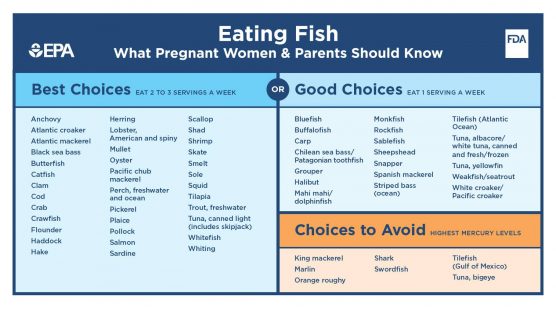On Wednesday, the U.S. Food and Drug Administration and the U.S. Environmental Protection Agency issued final advice regarding fish consumption. This advice is geared toward helping women who are pregnant or may become pregnant – as well as breastfeeding mothers and parents of young children – make informed choices when it comes to fish that are healthy and safe to eat. This advice refers to fish and shellfish collectively as “fish.”
To help these consumers more easily understand the types of fish to select, the agencies have created an easy-to-use reference chart that sorts 62 types of fish into three categories:
“Best choices” (eat two to three servings a week)
“Good choices” (eat one serving a week)
“Fish to avoid”
Fish in the “best choices” category make up nearly 90 percent of fish eaten in the United States.
An FDA analysis of fish consumption data found that 50 percent of pregnant women surveyed ate fewer than 2 ounces a week, far less than the amount recommended. Because the nutritional benefits of eating fish are important for growth and development during pregnancy and early childhood, the agencies are advising and promoting a minimum level of fish consumption for these groups. The advice recommends 2-3 servings of lower-mercury fish per week, or 8 to 12 ounces. However, all fish contain at least traces of mercury, which can be harmful to the brain and nervous system if a person is exposed to too much of it over time. The maximum level of consumption recommended in the final advice is consistent with the previous recommended level of 12 ounces per week. The new advice is consistent with the 2015 – 2020 Dietary Guidelines for Americans.
For adults, a typical serving is 4 ounces of fish, measured before cooking. Serving sizes for children should be smaller and adjusted for their age and total calorie needs. It is recommended that children eat fish once or twice a week, selected from a variety of fish types.
“Fish are an important source of protein and other nutrients for young children and women who are or may become pregnant, or are breastfeeding. This advice clearly shows the great diversity of fish in the U.S. market that they can consume safely,” said FDA Deputy Commissioner for Foods and Veterinary Medicine Stephen Ostroff, M.D. “This new, clear and concrete advice is an excellent tool for making safe and healthy choices when buying fish.” Choices lower in mercury include some of the most commonly eaten fish, such as shrimp, pollock, salmon, canned light tuna, tilapia, catfish and cod.
When updating the advice, the agencies took a cautious and highly protective approach to allow consumers to enjoy the benefits of fish while avoiding those with higher levels of mercury, which is especially important during pregnancy and early childhood. The average mercury content of each type of fish was calculated based on FDA data and information from other sources. The updated advice cautions parents of young children and certain women to avoid seven types of fish that typically have higher mercury levels: tilefish from the Gulf of Mexico; shark; swordfish; orange roughy; bigeye tuna; marlin; and king mackerel.
For fish caught recreationally, consumers are urged to check for local advisories where they are fishing and gauge their fish consumption based on any local and state advisories for those waters. If no information on fishing advisories is available, eat just one fish meal a week from local waters and also, avoid other fish that week. Consumers should clean and trim the fish they catch of fat and skin, since locally-caught fish may contain contaminants besides mercury that can be reduced by proper trimming and cooking, (e.g. broiling instead of frying can reduce some contaminants by letting fat drip away from the fish).
“It’s all about eating and enjoying fish of the right kind and in the right amounts,” said EPA Director for Water Science and Technology, Elizabeth Southerland, Ph.D. “This joint advice not only provides information for fish consumers who buy from local markets, but it also contains good information for people who catch their own fish or are provided fish caught by friends or relatives.”
All retailers, grocers and others are urged to post this new advice, including the reference chart listing fish to choose, prominently in their stores so consumers can make informed decisions when and where they purchase fish. The agencies will be implementing a consumer education campaign working with a wide array of public and private partners featuring the new advice.
In June 2014, the agencies issued draft advice which encouraged pregnant women and others to eat between 8 and 12 ounces of fish a week of fish “lower in mercury” but did not provide a list showing consumers which fish are lower in mercury. The advice issued today also takes into account more than 220 comments received from academia, industry, nongovernmental organizations and consumers as well as an external peer review of the information and method used to categorize the fish.
The FDA, an agency within the U.S. Department of Health and Human Services, protects the public health by assuring the safety, effectiveness, and security of human and veterinary drugs, vaccines and other biological products for human use, and medical devices. The agency also is responsible for the safety and security of our nation’s food supply, cosmetics, dietary supplements, products that give off electronic radiation, and for regulating tobacco products.
The EPA, a federal agency, works to protect all Americans from significant risks to human health and the environment where they live, learn and work. The agency focuses on all parts of society, from individuals to businesses and local governments. It develops regulations concerning natural resources, energy, transportation, agriculture, and industry and supports the various facets of environmental research and protection.
Like this:
Like Loading...
Related





 Tweet This
Tweet This Facebook
Facebook Digg This
Digg This Bookmark
Bookmark Stumble
Stumble RSS
RSS


























REAL NAMES ONLY: All posters must use their real individual or business name. This applies equally to Twitter account holders who use a nickname.
0 Comments
You can be the first one to leave a comment.